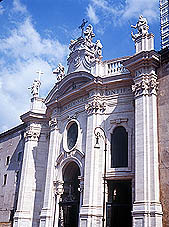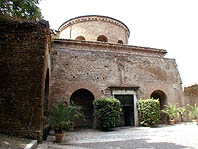Other Important Basilicas
St. Croce in Gerusalemme
This late Baroque church is noteworthy for its Holy Relics in their jewel-like reliquaries. On the left of the vestibule is a monastic herbal shop with remedies and perfumes.
The heavenly blue frescoes above the main altar set off the golden cherubs and curlicues of the 17 C baldachin. Go down the shallow steps on the right of the altar to visit St. Helena 's chapel with Melozzi's 15 C mosaic of Christ with saints, including St. Sylvester who dropped dead while saying mass here (restored a century later by Peruzzi and Zucchi).
Up the stairs through the door on the left is a handsome 1930's chapel housing the precious relics, including pieces of the True Cross, one of its nails, two thorns from Jesus' crown of thorns, and a shrivelled finger said to be the one with which Doubting Thomas, the Apostle, touched Christ's wound.
 St. Croce in Gerusalemme St. Croce in GerusalemmeHistory 2C AD. A Sessorian Imperial palace stood here. 218-235. Emperors Heliogabalus and Alexander Severus built the Circus Varianus and Amphitheater Castrense in the palace grounds. 320. St. Helena, Emperor Constantine's mother, inhabited this palace and added a chapel to house parts of the True Cross which she had brought back from a pilgrimage to Jerusalem. 1144. The bell tower was added during one of the church's innumerable reconstruction. 1741-44. Pope Benedict XIV (architects Domenico Gregorini and Pietro Passalacqua) added the facade, oval vestibule and ornately Rococo inside. |
Piazza Santa Croce in Gerusalemme, 12 (Beyond Map Area)
St. Agnese fuori le Mura
About a mile from Porta Pia out the Via Nomentana is this marvellous church complex (2 - 3 Century). Services on Sundays at St. Agnese are full - unusual in this day and age. There is a miraculous grotto and statue of the Virgin just outside the entrance. The hundreds of offerings and thank you plaques attest to its efficacy. Notice the fine Byzantine mosaic behind the altar.
Catacombs underneath the church are vast, 7 km long. They started as "tufo" quarries, then burial places (bodies unless cremated had to be buried outside the walls), it then became a site for worship during persecutions. Entrance to the catacombs is on the far wall at the rear of the Church.
The complex has a sports club for the young and old. “Bocce” pitches, football, tennis, club house - that is what makes the church live.
|
St. Agnese fuori le Mura
History Circa 300 AD. Saint Agnese was a Christian girl from a noble family who had land here. She became martyred when, in the time of Emperor Diocletian, spurning the advances of a Praetor's son, she was thrown into the arena of Domitian naked. Immediately her hair grew miraculously and covered her nudity. Then they tried to behead her. 625. Pope Onorio I built this little jewel of St. Agnese although it was an epoch notable for decadence. The church was never rebuilt - as most others were - in later centuries. The Saint was interred in the catacombs below the church. |
Via di Sant’Agnese (Beyond Map Area)
Mausoleum of St. Costanza
 (Mausoleo di S. Costanza). For us mosaic freaks by far the most satisfying mosaic art works are those that completely cover the vaulted ceiling of Santa Costanza.
(Mausoleo di S. Costanza). For us mosaic freaks by far the most satisfying mosaic art works are those that completely cover the vaulted ceiling of Santa Costanza.
They are truly fine Roman mosaics, created before the fall of Rome and before decadence set in (337 - 350 AD).
The subject matter of "putti" crushing grapes to make wine is charmingly alive and colorful.
They have perfect harmony, stamped by the same hand and add a lot to make this round mausoleum one of the most lovely places in all of Rome.
There is a peace, a religious quality to the building which is very uplifting, especially if there is a wedding ceremony going on with the melodious full bodied tones of an organ filling the air (the hall has perfect acoustics).
The old Basilica to which it was attached was absolutely vast - 98 meters long and 40 meters wide. St. Agnese is tiny in comparison.
|
Mausoleum of St. Costanza
History 4 Century AD. Emperor Constantine's daughter Costantia became converted to Christianity because, while praying at St. Agnese's tomb, her wounds were miraculously healed. She married twice, the King of Cappadocia in Turkey, and when he died, the Gallic Caesar. When she died in 354 AD in Bitinea, her body was sent back to Rome and laid to rest here - in a magnificent casket of “salami” red porphyry. |
Near Via di Sant’Agnese (Beyond Map Area)